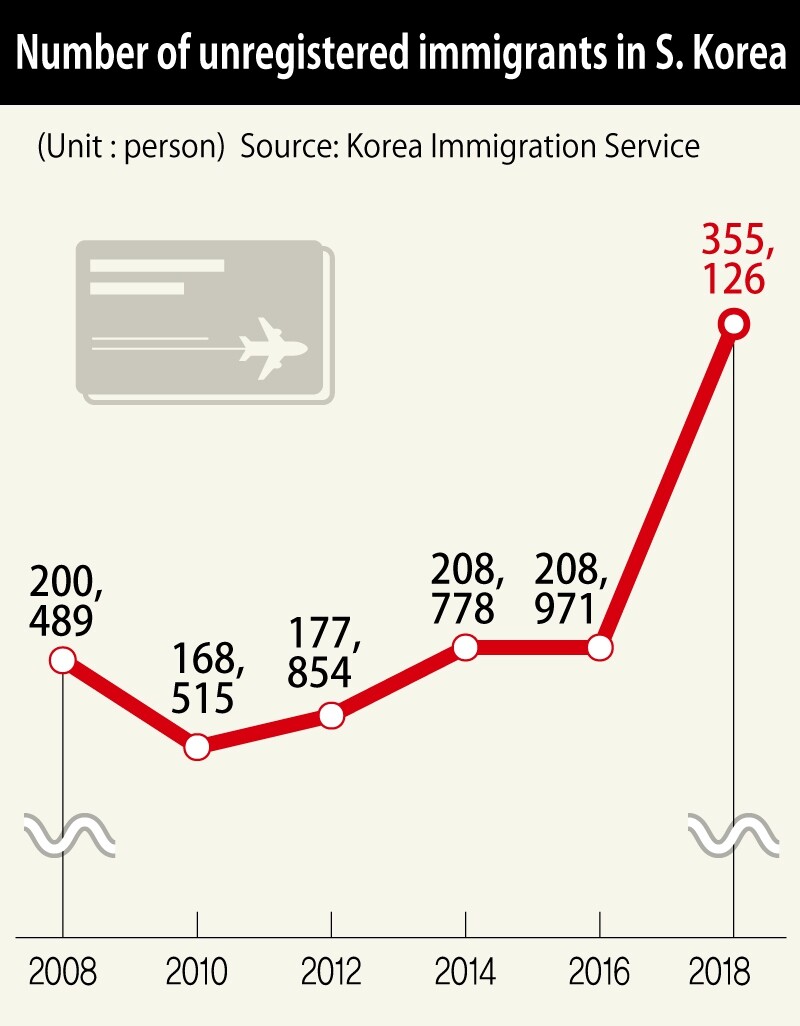hankyoreh
Links to other country sites 다른 나라 사이트 링크
S. Korean government cites increase in unregistered immigrants as reason for crackdowns

The South Korean government is citing a rapid increase in unregistered immigrants as a reason for intensifying crackdown efforts.
As of March 2019, the estimated number of unregistered immigrants stood at 356,095, or 14.9% of the 2,379,805 foreign nationals currently staying in South Korea. Major factors in the recent rapid rise include the success last year’s Winter Olympics in Pyeongchang and a government expansion of visa-free entries to attract foreign tourists. Of the 61,305 additional unregistered international residents calculated between late December 2017 (251,041) and late May 2018 (312,346), 52,213 entered South Korea without visas.
The response from some observers echoed the argument from Joint Committee with Migrants in Korea (JCMK) steering committee member Seok Won-jeong, who said the South Korean government “leaves in place the institutions and policies that lead to a proliferation in unregistered immigrants, while focusing only on crackdowns to manage the numbers.” Another factor behind the proliferation is the employment permit system that serves as a basis for employing migrant workers. Udaya Rai, head of the Migrants’ Trade Union, explained that “migrant workers who arrive through the employment permit system become ‘unregistered’ once they leave their workplace, even if they were suffering from verbal and/or physical abuse or poor working conditions.”
“Even if their employer consents to them changing workplaces, they become ‘unregistered’ if they fail to find a new job within three months, and a worker who is over 40 years of age has no choice but to remain unregistered if they hope to work in South Korea,” he added. The employment permit system grants permits only to immigrants between 18 and 40 years of age. Some 340,800 people were deported in crackdowns between 2000 and 2017.
“The Justice Ministry launches intensive crackdowns on construction sites, the last refuge for breadwinners in their 40s and 50s.”
Twelve days after the death of Myanmar migrant worker Than Zaw Htay on Sept. 20, 2018, the Ministry of Justice announced special policing measures intended to “prevent illegal foreign residents from taking away South Korean jobs in construction and other industries.”
“This is expected to produce job creation effects by restoring South Korean jobs previously held by illegal resident employees,” the explanation said. The announcement came a month after a flurry of reports in August 2018 stating that the number of employed persons was at its lowest since the global financial crisis, with a rise of just 3,000 from the same period in 2017. The Ministry of Justice pointed to the conflict over jobs between South Koreans and foreign nationals to legitimize the crackdown. It marked the emergence of a new logic citing employment woes as a basis for policing.
The multi-leveled subcontracting structure has been one factor making migrants the workforce of choice for the construction market. Companies have placed their subcontractors under pressure with shorter construction times and reduced construction spending. The subcontractors have cut costs in turn by hiring undocumented migrant workers, who work for little money and are unlikely to speak out about industrial accidents or unpaid wages. South Korea is now reaching a point where buildings can no longer be raised without migrant workers putting up with low wages and long working hours. Critics have accused the Ministry of Justice of blaming migrant workers for the employment shortage while ignoring distortions in the construction labor market as a result of multi-level subcontracting.
By Lee Moon-young, staff reporter
Please direct comments or questions to [english@hani.co.kr]

Editorial・opinion
![[Column] Park Geun-hye déjà vu in Yoon Suk-yeol [Column] Park Geun-hye déjà vu in Yoon Suk-yeol](https://flexible.img.hani.co.kr/flexible/normal/500/300/imgdb/original/2024/0424/651713945113788.jpg) [Column] Park Geun-hye déjà vu in Yoon Suk-yeol
[Column] Park Geun-hye déjà vu in Yoon Suk-yeol![[Editorial] New weight of N. Korea’s nuclear threats makes dialogue all the more urgent [Editorial] New weight of N. Korea’s nuclear threats makes dialogue all the more urgent](https://flexible.img.hani.co.kr/flexible/normal/500/300/imgdb/original/2024/0424/7317139454662664.jpg) [Editorial] New weight of N. Korea’s nuclear threats makes dialogue all the more urgent
[Editorial] New weight of N. Korea’s nuclear threats makes dialogue all the more urgent- [Guest essay] The real reason Korea’s new right wants to dub Rhee a founding father
- [Column] ‘Choson’: Is it time we start referring to N. Korea in its own terms?
- [Editorial] Japan’s rewriting of history with Korea has gone too far
- [Column] The president’s questionable capacity for dialogue
- [Column] Are chaebol firms just pizza pies for families to divvy up as they please?
- [Column] Has Korea, too, crossed the Rubicon on China?
- [Correspondent’s column] In Japan’s alliance with US, echoes of its past alliances with UK
- [Editorial] Does Yoon think the Korean public is wrong?
Most viewed articles
- 1‘We must say no’: Seoul defense chief on Korean, USFK involvement in hypothetical Taiwan crisis
- 2Will NewJeans end up collateral damage in internal feud at K-pop juggernaut Hybe?
- 3[Column] Park Geun-hye déjà vu in Yoon Suk-yeol
- 4Why Korea shouldn’t welcome Japan’s newly beefed up defense cooperation with US
- 5Thursday to mark start of resignations by senior doctors amid standoff with government
- 6N. Korean hackers breached 10 defense contractors in South for months, police say
- 7[Guest essay] The real reason Korea’s new right wants to dub Rhee a founding father
- 8[Column] ‘Choson’: Is it time we start referring to N. Korea in its own terms?
- 9Kim Jong-un expressed ‘satisfaction’ with nuclear counterstrike drill directed at South
- 10[Editorial] New weight of N. Korea’s nuclear threats makes dialogue all the more urgent